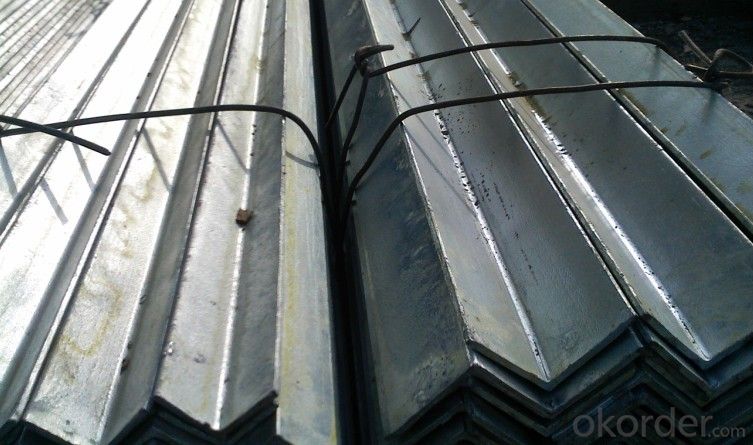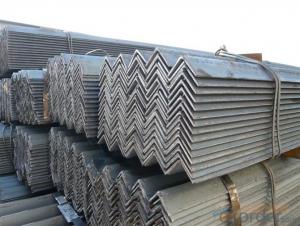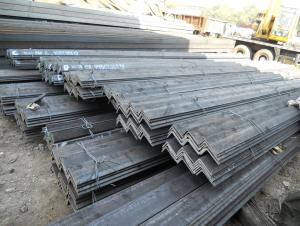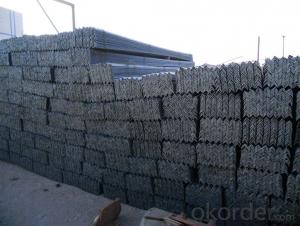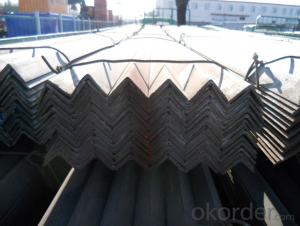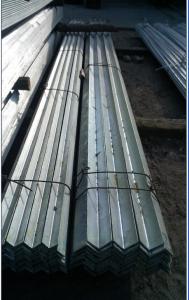GB Q235 Steel Angle with High Quality 30*30mm
- Loading Port:
- Tianjin
- Payment Terms:
- TT or LC
- Min Order Qty:
- 25 m.t
- Supply Capability:
- 10000 m.t/month
OKorder Service Pledge
OKorder Financial Service
You Might Also Like
Specifications of GB Q235 Steel Angle with High Quality 30*30mm:
1.Standards:GB
2.Length:6m, 12m
3.Material:Q235 or equivalent
4.Size:
Size (mm) | Mass (kg/m) | Size (mm) | Mass (kg/m) |
| 30*30*2.7 | 1.246 | 30*30*4 | 1.786 |
| 30*30*3.0 | 1.373 | 30*30*5 | 2.184 |
Usage & Applications of GB Q235 Steel Angle with High Quality 30*30mm:
Trusses;
Transmission towers;
Telecommunication towers;
Bracing for general structures;
Stiffeners in structural use.
Packaging & Delivery of GB Q235 Steel Angle with High Quality 30*30mm:
1. Transportation: the goods are delivered by truck from mill to loading port, the maximum quantity can be loaded is around 40MTs by each truck. If the order quantity cannot reach the full truck loaded, the transportation cost per ton will be little higher than full load.
2. With bundles and load in 20 feet/40 feet container, or by bulk cargo, also we could do as customers' request.
3. Marks:
Color mark: There will be color marking on both end of the bundle for the cargo delivered by bulk vessel. That makes it easily to distinguish at the destination port.
Tag mark: There will be tag mark tied up on the bundles. The information usually including supplier logo and name, product name, made in China, shipping marks and other information request by the customer.
If loading by container the marking is not needed, but we will prepare it as customers' request.
FAQ:
Q1: Why buy Materials & Equipment from OKorder.com?
A1: All products offered byOKorder.com are carefully selected from China's most reliable manufacturing enterprises. Through its ISO certifications, OKorder.com adheres to the highest standards and a commitment to supply chain safety and customer satisfaction.
Q2: How do we guarantee the quality of our products?
A2: We have established an advanced quality management system which conducts strict quality tests at every step, from raw materials to the final product. At the same time, we provide extensive follow-up service assurances as required.
Q3: How soon can we receive the product after purchase?
A3: Within three days of placing an order, we will arrange production. The shipping date is dependent upon the quatity, how many sizes you want and the plan of production, but is typically 30 to 45 days from the beginning of production.
Images of GB Q235 Steel Angle with High Quality 30*30mm:


*If you would like to get our price, please inform us the size, standard/material and quantity. Thank you very much for your attention.
- Q: How do you protect steel angles from chemical exposure?
- To protect steel angles from chemical exposure, there are several measures that can be taken: 1. Coatings: Applying protective coatings such as epoxy, polyurethane, or powder coatings can create a barrier between the steel surface and the chemicals. These coatings are specifically designed to resist chemical attacks and provide long-term protection. 2. Galvanization: Galvanizing steel angles involves applying a layer of zinc to the surface, forming a protective barrier. This process not only protects against chemical exposure but also provides excellent corrosion resistance. 3. Chemical-resistant paint: Using chemical-resistant paint, specifically formulated to withstand exposure to certain chemicals, can provide an added layer of protection. These paints are designed to resist the corrosive effects of various chemicals and prevent damage to the steel angles. 4. Plastic or rubber linings: In some cases, steel angles can be lined with plastic or rubber materials to protect them from chemical exposure. These linings act as a barrier, preventing direct contact between the steel and chemicals. 5. Proper ventilation: Ensuring proper ventilation in the area where steel angles are exposed to chemicals is crucial. Adequate ventilation helps to disperse and dilute the chemicals, reducing the overall exposure and minimizing the corrosive effects on the steel angles. 6. Regular inspection and maintenance: Regularly inspecting the steel angles for any signs of corrosion or damage caused by chemical exposure is vital. If any damage is detected, it should be repaired promptly to prevent further deterioration. It is important to note that the choice of protection method may vary depending on the type of chemicals involved, their concentration, and the specific environment in which the steel angles are exposed. Consulting with a professional or a corrosion specialist is recommended to determine the most suitable protection strategy for a particular application.
- Q: Can steel angles be used as supports for overhead doors or garage doors?
- Indeed, overhead doors or garage doors can rely on steel angles as their supports. Due to their impressive strength and durability, steel angles are frequently employed in construction. They offer superb support and stability for hefty doors, making them an ideal selection for overhead or garage doors. By securely fastening the angles to the walls or framework, a sturdy foundation is provided for the doors to hang on and function seamlessly. Moreover, steel angles can be tailored to fit the precise dimensions and weight prerequisites of the doors, guaranteeing adequate support and functionality.
- Q: How do you determine the load-bearing capacity of a steel angle?
- To determine the load-bearing capacity of a steel angle, several factors need to be considered. Firstly, the material properties of the steel angle must be known, such as its yield strength and ultimate tensile strength. These values can be obtained from the manufacturer or from relevant material standards. Next, the dimensions and shape of the steel angle play a crucial role in determining its load-bearing capacity. The angle's thickness, width, and length should be measured accurately. Additionally, the angle's shape, whether it is equal or unequal, must also be taken into account. Once these properties are known, the load-bearing capacity can be calculated using engineering principles and structural analysis methods. One common approach is to use the Euler's formula, which considers the bending and axial loads on the steel angle. The Euler's formula states that the load-bearing capacity of a steel angle is proportional to its moment of inertia and the modulus of elasticity. These values are calculated based on the dimensions and shape of the angle. Furthermore, other factors such as the angle's end supports, the type of loading (e.g., concentrated load or uniformly distributed load), and any additional factors of safety must be taken into consideration. It is important to note that determining the load-bearing capacity of a steel angle is a complex process that requires expertise in structural engineering. Therefore, it is recommended to consult with a qualified engineer or refer to relevant design codes and standards to ensure accurate and safe calculations.
- Q: How do steel angles contribute to the energy efficiency of a building?
- Steel angles can contribute to the energy efficiency of a building in several ways. Firstly, steel angles are commonly used as structural elements in the construction of buildings. They provide strength and support to the building's framework, allowing for the use of larger windows and open floor plans. This promotes natural daylighting and reduces the need for artificial lighting during the day, thereby reducing energy consumption. Additionally, steel angles can be used to create energy-efficient building envelopes. By incorporating steel angles into the construction of walls, roofs, and floors, thermal bridging can be minimized. Thermal bridging occurs when materials with high thermal conductivity, such as concrete or wood, allow heat to escape or enter the building, leading to increased energy consumption for heating or cooling. Steel, on the other hand, has a low thermal conductivity, which helps to reduce heat transfer and improve the overall thermal performance of the building envelope. Moreover, steel angles can be used in the installation of energy-saving systems and equipment. For instance, they can be used to support solar panels, which generate clean and renewable energy. Steel angles can also be utilized in the installation of HVAC systems, allowing for efficient air circulation and distribution throughout the building. By using steel angles in these applications, the energy efficiency of the building can be enhanced, leading to reduced energy consumption and lower utility bills. In conclusion, steel angles play a significant role in promoting energy efficiency in buildings. They contribute to the structural integrity of the building, help minimize thermal bridging, and can support the installation of energy-saving systems. By incorporating steel angles into the design and construction of a building, energy consumption can be reduced, resulting in a more sustainable and cost-effective built environment.
- Q: Are steel angles vulnerable to rusting?
- Certainly, rusting can affect steel angles. Steel, being predominantly composed of iron, is greatly prone to rusting upon exposure to moisture and oxygen. In the absence of a reliable corrosion-resistant coating or paint, it is highly likely for the steel angles to gradually accumulate rust. This rust accumulation can diminish the angles' structural durability, ultimately undermining their effectiveness. In order to minimize the risk of rusting and extend the lifespan of steel angles, it is important to regularly maintain them and employ suitable rust prevention measures such as painting or galvanizing.
- Q: Are there any environmental concerns related to the production or disposal of steel angles?
- Yes, there are several environmental concerns related to the production and disposal of steel angles. Firstly, the production of steel angles requires large amounts of energy and raw materials, such as iron ore and coal. The extraction of these resources can have detrimental effects on the environment, including habitat destruction, deforestation, and air and water pollution. Additionally, the manufacturing process itself emits greenhouse gases and other pollutants, contributing to climate change and air pollution. Furthermore, the disposal of steel angles can be problematic. Steel is not easily biodegradable and can take hundreds of years to decompose. Improper disposal, such as landfilling or incineration, can lead to the release of toxic substances and contribute to soil and water contamination. To mitigate these environmental concerns, several measures can be taken. Firstly, improving the efficiency of steel production processes can reduce energy consumption and emissions. The use of recycled steel in the production of steel angles can also help decrease the demand for raw materials and reduce environmental impacts. Additionally, implementing proper waste management and recycling programs can minimize the environmental footprint of steel angle disposal. Overall, while steel angles are essential in various industries and construction, their production and disposal can have significant environmental implications. It is crucial to prioritize sustainable practices and technologies to mitigate these concerns and promote a more environmentally friendly approach to steel angle production and disposal.
- Q: What is the typical length of a steel angle?
- The typical length of a steel angle can vary depending on the specific application or project requirements. However, standard lengths for steel angles often range from 10 to 20 feet.
- Q: How do steel angles perform in terms of sound insulation?
- Steel angles are not known for their sound insulation properties. Due to their rigid and dense nature, steel angles have little ability to absorb or dampen sound waves. This means that they do not provide significant sound insulation on their own. However, when used in combination with other materials such as acoustic insulation, steel angles can contribute to the overall sound insulation of a structure. Additionally, the thickness and design of the steel angles can also have an impact on their sound insulation performance. Overall, while steel angles may not offer exceptional sound insulation properties, they can still play a role in improving the overall soundproofing of a building when used in conjunction with other soundproofing materials.
- Q: What is the maximum load capacity for a steel angle bracket?
- The maximum load capacity for a steel angle bracket depends on various factors such as the dimensions of the bracket, the thickness and quality of the steel used, the method of installation, and the intended use of the bracket. Generally, steel angle brackets are designed to support heavy loads and can handle significant weight. However, it is crucial to consult the manufacturer's specifications or engineering guidelines for the specific bracket in question to determine its maximum load capacity. These specifications will provide accurate information on the maximum weight or load that the steel angle bracket can safely support without compromising its structural integrity.
- Q: Are steel angles corrosion resistant?
- Steel angles are generally not corrosion resistant unless they are specifically designed and treated to be so. Regular steel angles are made from carbon steel, which is susceptible to corrosion when exposed to moisture, oxygen, and other corrosive elements. However, there are stainless steel angles available that have a higher resistance to corrosion due to the addition of chromium and other alloying elements. These stainless steel angles are commonly used in environments where corrosion is a concern, such as marine or industrial applications. It is important to consider the specific type and grade of steel angle being used to determine its corrosion resistance capabilities.
Send your message to us
GB Q235 Steel Angle with High Quality 30*30mm
- Loading Port:
- Tianjin
- Payment Terms:
- TT or LC
- Min Order Qty:
- 25 m.t
- Supply Capability:
- 10000 m.t/month
OKorder Service Pledge
OKorder Financial Service
Similar products
Hot products
Hot Searches
Related keywords



